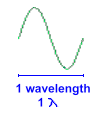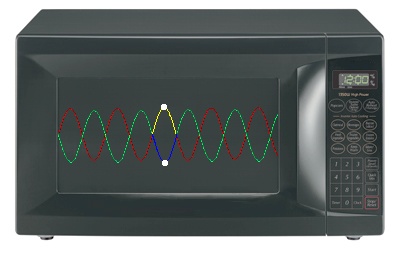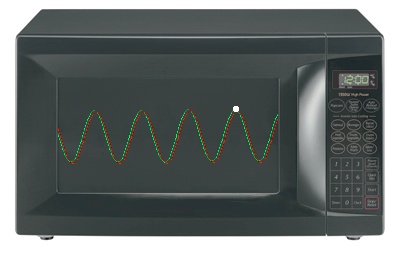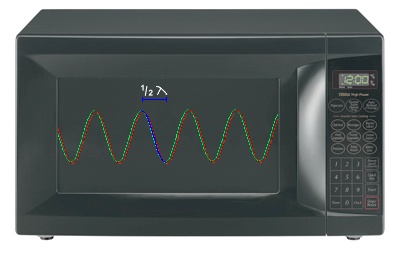 WHY IT WORKS How a Microwave Oven Works A microwave oven contains a device called a magnetron, which is a radio transmitter; it emits electromagnetic waves whose wavelength, being fairly short, is described as 'microwaves'. A wavelength of microwave energy is typically about 12 cm long. It has a frequency (in an oven) of 2450 MHz; this frequency isn't used by radios, TVs, phones or other devices, so the microwaves don't interfere with them. The walls inside the microwave oven are metal. Microwaves reflect off metal, so the waves bounce around inside the oven until they hit something else. The waves are just the right frequency to be absorbed by molecules of water ... but not by plastics, glass or ceramics. Food has a lot of water in it. A water molecule that encounters a microwave will absorb energy from it as it tries to line up with the magnetic field of the wave. This results in many water molecules rotating inside the food. Energy is released as friction, as the molecules bump into each other. (Water molecules are polarized; one end is more negative than the other. What happens to them is quite similar to what happens to the needle of a compass when it turns to line up with the magnetic field of the Earth). Moreover, since the microwave energy is oscillating back and forth at 2450 million vibrations per second, the water molecules are constantly being forced to line up one way and then the other. This causes a lot of friction, and a lot of heat, as they jostle each other inside your food. By the way, the frequency of 2450 MHz used in microwave ovens is not the only frequency that will affect water molecules this way; 2200 or 2500 MHz would work just fine. The particular frequency used was chosen originally decades ago by a licensing organization, and has been used consistently since. Why Hotspots Are Half a Wavelength Apart A problem with microwave ovens is that, while they heat up all the water molecules at once, causing fairly uniform 'cooking' of the food, they don't penetrate all foods evenly, and they cause 'hotspots'. It's the distance between these 'hotspots' that let us calculate the wavelength of the radiation. When two or more waves pass each other at a certain spot, the waves can meet in certain ways. If the crest of one wave meets at the trough of another, the two waves may 'cancel each other out', and produce no effect on the water molecules there. Alternatively, if the crest of one wave meets the crest of another, the two waves will add to each other and produce a 'supertrough'. This effect is called interference. Waves which interfere such that they cancel each other result in a cold spot. Waves overlapping such that crests match one another interfere constructively, forming a hot spot.  Let's look at what happens inside a microwave oven.
Let's look at what happens inside a microwave oven.At the left is a diagram of a wave. It rises to a crest, and then falls to a trough. One full wavelength is shown. In a microwave oven, 2450 million of them pass by a given spot every second. Microwaves inside the oven may bounce off the walls in such a way as to set up standing waves. This means that the crests and troughs of a particular wave always stay at the same location. There are many different waves, all generated by the magnetron, and all filling the interior of the oven. Examine the picture below. It shows two particular waves travelling across the oven. They are out of phase; this means that they aren't peaking at the same spot. In fact, the crests of the green wave meet where the troughs of the red wave are. For example, looking at the parts of the wave coloured blue and yellow, you can see that a water molecule at the horizontal location where the white dots are will experience waves pulling it in opposite directions with the same energy, so it won't move. Little or no energy will be given to the water molecules here, so this area won't get heated.    and The Speed of Light (an explanation of how it was originally measured) |